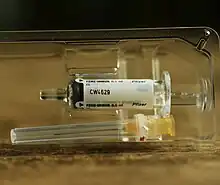 FSME-Immun (European TBE vaccine) | |
| Vaccine description | |
|---|---|
| Target | Tick-borne encephalitis virus |
| Vaccine type | Inactivated |
| Clinical data | |
| Trade names | Encepur N, FSME-Immun CC, Ticovac, others |
| Routes of administration | Intramuscular |
| ATC code | |
| Legal status | |
| Legal status | |
| Identifiers | |
| CAS Number | |
| DrugBank | |
| ChemSpider |
|
| KEGG | |
| | |
Tick-borne encephalitis vaccine is a vaccine used to prevent tick-borne encephalitis (TBE).[4] The disease is most common in Central and Eastern Europe, and Northern Asia.[4] More than 87% of people who receive the vaccine develop immunity.[5] It is not useful following the bite of an infected tick.[4] It is given by injection into a muscle.[4]
The World Health Organization (WHO) recommends immunizing all people in areas where the disease is common.[4] Otherwise the vaccine is just recommended for those who are at high risk.[4] Three doses are recommended followed by additional doses every three to five years.[4] The vaccines can be used in people more than one or three years of age depending on the formulation.[4] The vaccine appears to be safe during pregnancy.[4]
Serious side effects are very uncommon.[4] Minor side effects may include fever, and redness and pain at the site of injection.[4] Older formulations were more commonly associated with side effects.[4]
The first vaccine against TBE was developed in 1937.[4] It is on the World Health Organization's List of Essential Medicines.[6][7] The vaccine was approved for medical use in the United States in August 2021.[2][3][8][9]
Medical uses
In the United States, tick-borne encephalitis vaccine is indicated for active immunization to prevent tick-borne encephalitis (TBE) in individuals one year of age and older.[2]
The efficacy of these vaccines has been well documented.[4] They have also been shown to protect mice from a lethal challenge with several TBE-virus isolates obtained over a period of more than 30 years from all over Europe and the Asian part of the former Soviet Union. In addition, it has been demonstrated that antibodies induced by vaccination of human volunteers neutralized all tested isolates.
Pregnancy and breastfeeding
The vaccine appears to be safe during pregnancy,[4] but because of insufficient data the vaccine is only recommended during pregnancy and breastfeeding when it is considered urgent to achieve protection against TBE infection and after careful consideration of risks versus benefits.[10]
Schedule
Two to three doses are recommended depending on the formulation. Typically one to three months should occur between the first doses followed by five to twelve months before the final dose. Additional doses are then recommended every three to five years.[4] A study from 2006 suggests that the FSME-Immun/Ticovac and Encepur are interchangeable for booster vaccination, but cautions against change during the primary immunization course.[11]
History
The first vaccine against TBE was prepared in 1937 in the brains of mice. Some 20 years later TBE vaccines derived from cell cultures (chicken embryo fibroblast cells) were developed and used for active immunization in humans in the former Soviet Union. Later, a purified, inactivated virus vaccine was developed which proved to be more immunogenic than previous TBE vaccines.[12]
Society and culture
Economics
Per dose it costs between £50 and £70 in the United Kingdom.[13]
Brand names
Brand names of the vaccines include Encepur N,[14] FSME-Immun CC[15] and Ticovac,[1] Encevir-Neo, Klesh-E-Vak.
References
- 1 2 "TicoVac 0.5 ml Suspension for injection in a prefilled syringe - Summary of Product Characteristics (SmPC)". (emc). Retrieved 23 August 2021.
- 1 2 3 "Ticovac". U.S. Food and Drug Administration (FDA). 16 August 2021. STN: 125740. Retrieved 23 August 2021.
 This article incorporates text from this source, which is in the public domain.
This article incorporates text from this source, which is in the public domain. - 1 2 "U.S. FDA Approves Ticovac, Pfizer's Tick-Borne Encephalitis (TBE) Vaccine". Pfizer (Press release). Retrieved 23 August 2021.
- 1 2 3 4 5 6 7 8 9 10 11 12 13 14 15 16 "Vaccines against tick-borne encephalitis: WHO position paper" (PDF). Relevé Épidémiologique Hebdomadaire. 86 (24): 241–256. June 2011. hdl:10665/241769. PMID 21661276.
- ↑ Demicheli V, Debalini MG, Rivetti A (January 2009). "Vaccines for preventing tick-borne encephalitis". The Cochrane Database of Systematic Reviews. 2009 (1): CD000977. doi:10.1002/14651858.CD000977.pub2. PMC 6532705. PMID 19160184.
- ↑ World Health Organization (2019). World Health Organization model list of essential medicines: 21st list 2019. Geneva: World Health Organization. hdl:10665/325771. WHO/MVP/EMP/IAU/2019.06. License: CC BY-NC-SA 3.0 IGO.
- ↑ World Health Organization (2021). World Health Organization model list of essential medicines: 22nd list (2021). Geneva: World Health Organization. hdl:10665/345533. WHO/MHP/HPS/EML/2021.02.
- ↑ "First Tick-Borne Encephalitis Vax Approved in the U.S." 16 August 2021.
- ↑ "3: Infectious Diseases Related to Travel". CDC Health Information for International Travel 2016. Oxford University Press. 1 June 2015. ISBN 978-0199379156. Archived from the original on 11 June 2016.
- ↑ Gabutti G, Conforti G, Tomasi A, Kuhdari P, Castiglia P, Prato R, et al. (February 2017). "Why, when and for what diseases pregnant and new mothers "should" be vaccinated". Human Vaccines & Immunotherapeutics. 13 (2): 283–290. doi:10.1080/21645515.2017.1264773. PMC 5328236. PMID 27929742.
- ↑ Bröker M, Schöndorf I (August 2006). "Are tick-borne encephalitis vaccines interchangeable?". Expert Review of Vaccines. 5 (4): 461–466. doi:10.1586/14760584.5.4.461. PMID 16989626. S2CID 32915267.
- ↑ Plentz A, Jilg W, Schwarz TF, Kuhr HB, Zent O (February 2009). "Long-term persistence of tick-borne encephalitis antibodies in adults 5 years after booster vaccination with Encepur Adults". Vaccine. 27 (6): 853–856. doi:10.1016/j.vaccine.2008.11.082. PMID 19071180.
- ↑ "Tick-borne encephalitis - Prevention". NHS.uk. 15 October 2015. Archived from the original on 22 December 2015. Retrieved 15 December 2015.
- ↑ "Encepur N". compendium.ch. 28 April 2016. Retrieved 21 January 2018.
- ↑ "FSME-Immun CC". compendium.ch. 11 August 2017. Retrieved 21 January 2018.
External links
- "Tick-borne Encephalitis Vaccine". World Health Organization (WHO). 12 October 2011. Archived from the original on 15 May 2006.